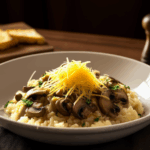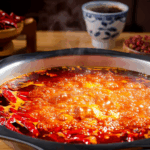Warm Bowl of Comfort: Grandma’s Superior Wanton Soup
Introduction:
In the realm of comfort food, few dishes can rival the warmth and nostalgia that comes with a bowl of grandma’s superior wanton soup. This traditional Chinese dish is not just a meal; it’s a journey through time, a taste of home, and a testament to the love and care that goes into every bite. In this article, we will explore the history, preparation, and significance of this beloved soup, offering you a step-by-step guide to crafting the perfect bowl at home.
The History and Significance of Wanton Soup
Wanton soup, or “wonton” in Cantonese, has a rich history dating back centuries. Originating in southern China, particularly in the Guangdong region, it has since spread across the globe, becoming a staple in many Chinese households and restaurants. The word “wonton” translates to “swallowing clouds,” reflecting its delicate, ethereal nature. Each dumpling is a small cloud floating in a sea of broth, encapsulating flavors that are both comforting and complex.
The soup itself is a symphony of ingredients, each playing a crucial role in creating the perfect balance of flavors. From the silky wontons to the aromatic broth, every element contributes to the overall experience. It’s no wonder that this dish has become a symbol of home for so many people, especially those who grew up enjoying it at their grandmother’s table.
The Ingredients You’ll Need
To create a truly authentic and delicious bowl of wanton soup, you’ll need a variety of high-quality ingredients. Here’s a comprehensive list to get you started:
- Ground pork (or chicken)
- Wheat starch
- Fresh shrimp (optional)
- Garlic
- Ginger
- Green onions
- Soy sauce
- Sesame oil
- Pepper
- Water chestnuts (optional)
- Vegetable oil
- Bone broth (chicken or pork)
- Spring onions for garnish
- Chili oil (optional)
- White pepper powder
- Sesame seeds for garnish
Each ingredient plays a vital role in the final product. For instance, wheat starch is essential for making the wonton wrappers thin and pliable, while bone broth adds depth and richness to the soup. Fresh shrimp, if used, elevates the dish with its natural sweetness, and chili oil provides an optional kick of heat.
The Art of Making Wonton Wrappers
The first step in preparing your wanton soup is crafting the perfect wrappers. While store-bought wrappers are convenient, homemade ones offer a superior texture and flavor. Here’s how you can make them:
- Prepare the Dough: In a large mixing bowl, combine 1 cup of wheat starch with 1/2 cup of tapioca flour. Gradually add water until the mixture forms a dough. Knead the dough thoroughly until it becomes smooth and elastic.
- Roll Out the Dough: Once the dough is ready, roll it out as thinly as possible. A pasta machine can be very helpful here, allowing you to achieve the desired thinness easily.
- Cut the Wrappers: Using a round cookie cutter or a glass, cut out circles from the rolled-out dough. These will serve as the base for your wontons.
- Rest the Wrappers: Let the wrappers rest for about 30 minutes before filling them. This allows them to become more pliable and easier to work with.
Homemade wrappers may take a bit more effort, but the result is well worth it. They add a unique texture and flavor that store-bought options simply cannot replicate.
Preparing the Filling
The filling is where the magic happens. A good filling should be flavorful yet light, ensuring that each bite bursts with taste without overwhelming the palate. Here’s a recipe for a classic pork and shrimp filling:
- Finely chop: Finely chop 1/2 cup of ground pork and 1/4 cup of finely chopped fresh shrimp (if using).
- Grate: Grate 1/4 cup of water chestnuts (optional).
- Mince: Mince 2 cloves of garlic and 1 tablespoon of ginger.
- Combine: Combine all the ingredients in a mixing bowl. Add 1 teaspoon of soy sauce, 1/2 teaspoon of sesame oil, and a pinch of white pepper powder. Mix everything together thoroughly.
- Taste and Adjust: Taste the mixture and adjust seasoning as needed. The filling should be slightly sweet, savory, and aromatic.
This filling is versatile and can be adjusted based on personal preference. Feel free to experiment with different meats, vegetables, or spices to create your own signature version.
Assembling the Wontons
Now that you have your wrappers and filling ready, it’s time to assemble the wontons:
- Place a wrapper: Place a wonton wrapper on a clean surface.
- Add filling: Place about 1 tablespoon of filling in the center of the wrapper.
- Moisten edges: Moisten the edges of the wrapper with water.
- Seal the wonton: Fold the wrapper over the filling and press the edges together to seal. You can pleat the edges for a decorative touch.
- Repeat: Repeat the process until all the wrappers and filling are used.
Proper sealing is key to preventing the filling from leaking during cooking. If done correctly, each wonton should hold its shape beautifully once submerged in the broth.
Creating the Broth
The broth is the soul of any good wanton soup. It should be rich, flavorful, and deeply satisfying. Here’s how to prepare the perfect broth:
- Simmer bones: Simmer chicken or pork bones in a large pot of water for several hours. Skim off any impurities that rise to the surface.
- Add aromatics: Add 2 tablespoons of soy sauce, 1 tablespoon of sesame oil, 1 tablespoon of minced ginger, and 2 cloves of minced garlic. Simmer for another 30 minutes.
- Strain the broth: Strain the broth to remove any solids. Return the strained broth to the pot and keep it warm.
The resulting broth should be clear, golden, and full of umami. It’s the perfect base for your wontons and other ingredients.
Cooking the Wontons
Once your broth is ready, it’s time to cook the wontons:
- Bring broth to a boil: Bring the broth to a rolling boil.
- Drop in wontons: Gently drop the assembled wontons into the boiling broth.
- Cook: Cook the wontons for about 3-5 minutes, or until they float to the surface and are fully cooked.
- Remove and serve: Remove the wontons from the broth using a slotted spoon and place them in individual serving bowls.
Ensure that the wontons are evenly cooked and tender. Overcooking can lead to a mushy texture, so it’s important to monitor them closely.
Garnishing Your Bowl
The final step is to garnish your bowl of wanton soup, adding the finishing touches that elevate it from a simple meal to a culinary masterpiece:
- Spring onions: Chopped spring onions provide a fresh, crisp contrast to the warm, savory soup.
- Chili oil: A drizzle of chili oil adds a spicy kick, perfect for those who enjoy a bit of heat.
- Sesame seeds: Toasted sesame seeds bring a nutty aroma and texture to the dish.
- White pepper powder: A sprinkle of white pepper powder enhances the overall flavor profile.
These garnishes not only enhance the visual appeal of the soup but also add layers of flavor and texture that complement the wontons and broth perfectly.
Conclusion
Grandma’s superior wanton soup is more than just a dish; it’s a reflection of tradition, love, and the joy of sharing a meal with family. By following this detailed guide, you can recreate this timeless favorite in your own kitchen, bringing a little piece of home to every bowl. Whether enjoyed on a chilly evening or as part of a larger feast, this soup promises to warm your heart and satisfy your soul.


